
For reliable feeding of flow-resistant bulk materials to processing machines in the food, plastics and chemical industry. The materials can be picked up from e.g. sacks, drums, containers or silos. The type S... receivers are used as individual receivers, with a separate blower each, in discontinuous vacuum, low-velocity vacuum and dense-phase vacuum conveying systems. They are mounted on the batch hoppers of the processing machines where they serve for separating the bulk materials.
Filter with compressed air purging. Outlet flange to fit the rotary feeder, including conveying and clean air connection with electronic control or PLC control connection. Mounted on customer’s machine hopper by means of screws. All parts in contact with product of stainless steel, roll-bright and polished surfaces, ground welding seams.
When switching the blower on, a vacuum is generated causing the product to be transferred via the conveying line from the pickup point to the receiver. Simultaneously the rotary feeder discharges the product into the surge bin of the processing machine. Product is conveyed until the request indicator reacts. When the product level in the surge bin drops, a new conveying phase begins. During the conveying phase the filter is purged by automatic compressed air pulses, which permits continuous operation. The sequence of the operating cycles is controlled by an electronic control system. The actual operating state is displayed at the electronic control.